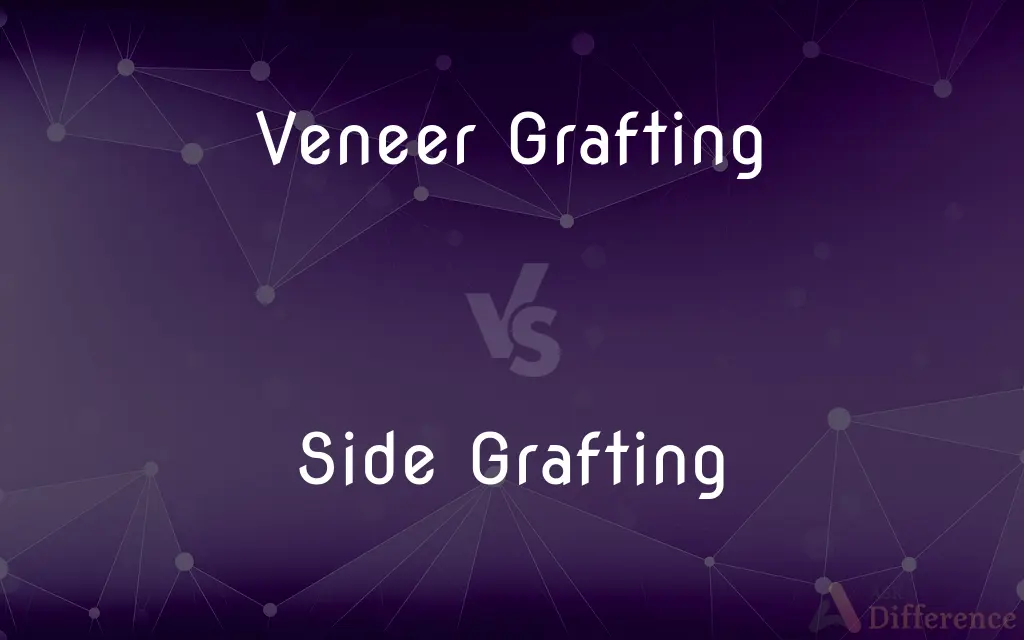Veneer Grafting vs. Side Grafting — What's the Difference?
By Tayyaba Rehman — Published on January 28, 2024
Veneer grafting involves attaching a scion to the side of the rootstock, while side grafting attaches the scion to a cut on the side of the rootstock's stem.

Difference Between Veneer Grafting and Side Grafting
Table of Contents
ADVERTISEMENT
Key Differences
Veneer grafting, a technique in horticulture, involves placing a scion (a young shoot or twig) onto the side of a rootstock, usually matching the cambium layers. Side grafting, another horticultural method, involves attaching the scion to a side cut made on the stem of the rootstock, with the scion typically having multiple buds.
In veneer grafting, the scion is usually a single bud or a piece of stem. This technique is commonly used for woody plants and trees. Side grafting, on the other hand, can involve a larger scion and is often used for plants that are difficult to graft, such as certain fruit trees.
The veneer graft is known for its simplicity and high success rate, making it suitable for beginners in grafting. Side grafting requires more skill and precision, as it involves a more complex cut and alignment of the scion and rootstock.
Veneer grafting is often used in situations where the rootstock is larger in diameter than the scion. In contrast, side grafting is commonly employed when the diameters of the scion and rootstock are similar, allowing for a better connection and nutrient flow.
The choice between veneer and side grafting depends on the type of plants being grafted, the desired outcome, and the skill level of the grafter. Both methods have their specific applications and advantages in the field of botany and horticulture.
ADVERTISEMENT
Comparison Chart
Scion Placement
On the side of the rootstock
In a side cut on the rootstock's stem
Scion Type
Usually a single bud or stem piece
Typically a larger scion with multiple buds
Technique Complexity
Simpler, suitable for beginners
More complex, requires skill
Rootstock-Scion Size
Rootstock larger than scion
Similar diameters of rootstock and scion
Common Use
Woody plants and trees
Difficult-to-graft plants, some fruit trees
Compare with Definitions
Veneer Grafting
A grafting technique known for simplicity and high success rate.
Veneer grafting is my go-to method for its ease and effectiveness.
Side Grafting
Typically uses a larger scion with multiple buds.
The side graft I did had a scion with several healthy buds.
Veneer Grafting
Ideal when the rootstock is larger than the scion.
Since the rootstock was thicker, I opted for veneer grafting.
Side Grafting
Commonly used for difficult-to-graft fruit trees.
For the challenging peach tree, I used the side grafting method.
Veneer Grafting
Attaching a scion to the side of a rootstock.
I used veneer grafting to propagate my favorite apple tree.
Side Grafting
Involves a more complex cut and alignment.
Precise cutting was essential for the success of my side graft.
Veneer Grafting
Suitable for woody plants and trees.
Veneer grafting works well for my ornamental woody shrubs.
Side Grafting
Attaching a scion to a side cut on the rootstock's stem.
Side grafting was perfect for grafting my heirloom tomato plants.
Veneer Grafting
Often used with a single bud or stem piece as a scion.
For the veneer graft, I selected a healthy bud from the donor plant.
Side Grafting
Suitable when scion and rootstock diameters are similar.
The similar size of the scion and rootstock made side grafting ideal.
Common Curiosities
Is side grafting suitable for grafting citrus trees?
Yes, it can be effective for citrus and other fruit trees.
Can side grafting be done by beginners?
It requires more skill, so it's more challenging for beginners.
Can veneer grafting be used on all types of plants?
It's most effective on woody plants and certain trees.
Can I use side grafting on roses?
Yes, it can be effective for roses and similar plants.
When is side grafting preferred?
For plants that are difficult to graft and when scion and rootstock sizes are similar.
Do I need special tools for veneer grafting?
Basic grafting tools like a sharp knife and grafting tape are usually sufficient.
What's the main difference in scion selection between the two methods?
Veneer grafting often uses a single bud, while side grafting uses larger scions.
What is the main advantage of veneer grafting?
Its simplicity and high success rate, especially for beginners.
What time of year is best for veneer grafting?
Late winter or early spring, just before the growth season begins.
How long does it take for a veneer graft to heal?
Healing time varies but typically ranges from a few weeks to a few months.
How do I care for a veneer graft?
Keep it moist and protected, and ensure the graft union is not stressed.
What's the success rate of side grafting?
It varies but can be high with proper technique and plant selection.
How do I protect a side graft?
Use grafting tape or wax to protect the graft and maintain moisture.
Are there specific conditions that favor side grafting?
Moderate temperatures and high humidity can be beneficial.
Is it necessary to match the cambium layers in veneer grafting?
Yes, matching the cambium layers is crucial for successful grafting.
Share Your Discovery

Previous Comparison
Public Sector vs. Joint Sector
Next Comparison
Black Seed vs. Onion SeedAuthor Spotlight
Written by
Tayyaba RehmanTayyaba Rehman is a distinguished writer, currently serving as a primary contributor to askdifference.com. As a researcher in semantics and etymology, Tayyaba's passion for the complexity of languages and their distinctions has found a perfect home on the platform. Tayyaba delves into the intricacies of language, distinguishing between commonly confused words and phrases, thereby providing clarity for readers worldwide.












































